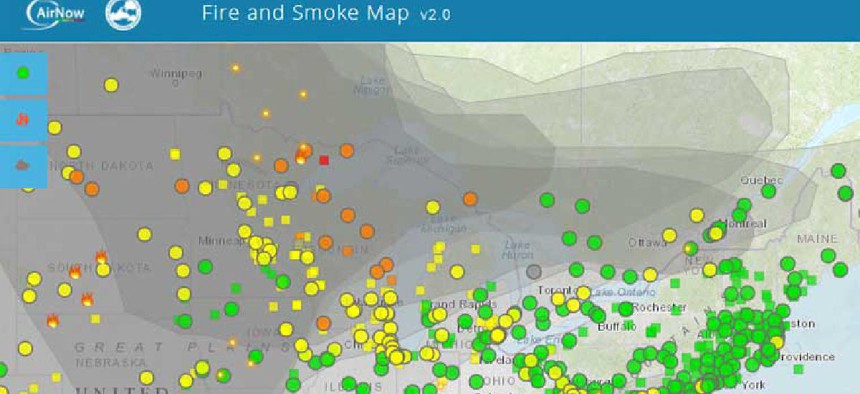Crowdsourced sensor data powers smoke map

The Fire and Smoke Map shows fine particle pollution from permanent EPA and Forest Service AirNow monitors, temporary monitors deployed by agencies for smoke events and crowdsourced low-cost sensors.
The Environmental Protection Agency and the U.S. Forest Service (USFS) have released updates to the AirNow Fire and Smoke Map to help protect communities from the effects of wildfire smoke.
Started as a pilot project last year, the map pulls data from three sources: temporary monitors such as those the Forest Service and other agencies have deployed near fires; crowdsourced data from nearly 10,000 low-cost sensors nationwide that measure fine particle pollution, the major harmful pollutant in smoke; and monitors that regularly report to AirNow, EPA’s “one-stop source for air quality data.”
On July 19, the agencies announced improvements to the map, including a dashboard that gives users quick access to information that can help them plan their outdoor activities, the current Air Quality Index category at the monitor or sensor location, data showing whether air quality is improving or worsening, and information about actions to consider taking based on the AQI.
EPA and USFS developed the map pilot to provide information on fire locations, smoke plumes and air quality in one place. It had more than 7.4 million views in its first three months.
The map imports data from almost 10,000 sensors from PurpleAir, an air quality sensor network that crowdsources data on particle pollution, providing real-time measurement of air quality on a public map. This was a logical addition to two other projects already under way, Tim Carroll, EPA’s deputy press secretary, wrote in an email to GCN: the Forest Service’s Interagency Wildland Fire Air Quality Response Program and EPA’s AirNow Program.
“The extra data points the sensors provided proved useful in characterizing air quality during the 2020 fire season, and we had positive reception from state, local and tribal air agency partners, and from the public,” Carroll said.
The map is intended for individuals to use in making decisions about outdoor activities based on air quality, he added, but “the unique fire, smoke and concentration data can help increase awareness of the significant impacts … wildfires across all levels of government -- federal, state, local and tribal -- and provide a valuable tool to assist agencies as they work to protect public health from wildfire smoke during these emergencies.”
Officials can use the map to compare current air quality from the three main data sources and to view fire locations, basic fire information (if available) and smoke plume information.
“Most sensors are operated by private citizens monitoring air quality where it is important to them,” Carroll said. “PurpleAir sensor users can choose to contribute their data to a public crowdsourced database. Sensor data is transmitted by Wi-Fi back to PurpleAir’s database. PurpleAir has partnered with EPA and USFS to provide real-time data to the AirNow Fire and Smoke Map.”
To make PurpleAir data more comparable to smoke monitor data on the AirNow Fire and Smoke Map, EPA’s Office of Research and Development built a correction equation. When data is imported, the map displays only sensors labeled as outdoor, removes questionable data when internal sensors disagree, applies the correction equation, and then harnesses NowCast, EPA’s method for relating hourly data to the AQI, to show data in the context of the index.
“In 2020, if you clicked on a monitor or sensor icon on the map, you would get a popup box showing the recent air quality history at that location -- both in terms of the NowCast AQI and in terms for fine particle concentrations,” Carroll said. “The changes EPA and USFS released [July 22] put a lot more information at the user’s fingertips. Now when you click on a monitor or sensor, you get the dashboard that shows you the current NowCast AQI, gives you quick information on how you may need to take precautions, and shows you whether recent air quality (usually the past 30 minutes) at the location has improved, worsened, or stayed the same.”
The sensor data is not used on other maps on the AirNow website, to calculate the NowCast AQI or to forecast AQI on the AirNow homepage or app, EPA says.
“We’re exploring other ways to make air quality information more broadly available to the public,” Carroll said. “The next step in that work is getting the Fire and Smoke Map included in the AirNow app. Look for that in the coming weeks.”
NEXT STORY: How data can help reduce transportation inequity





